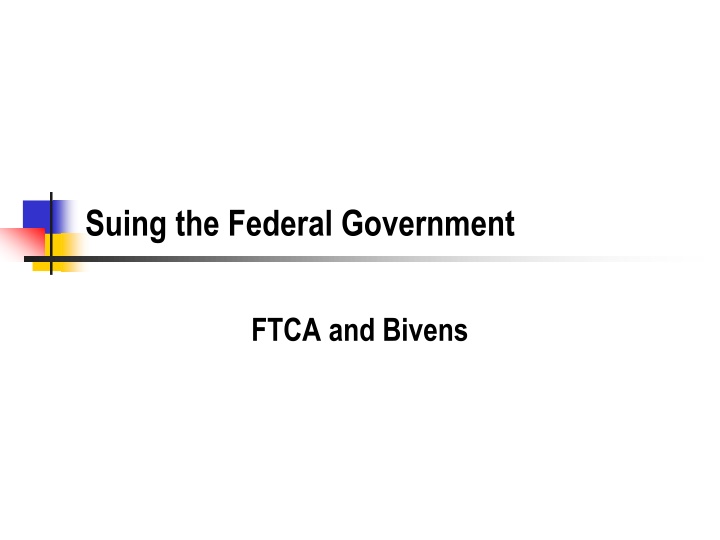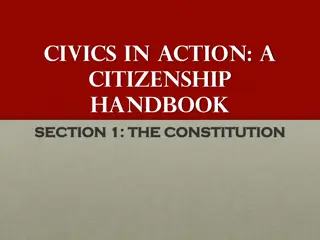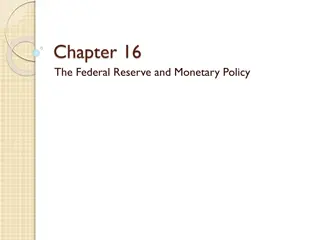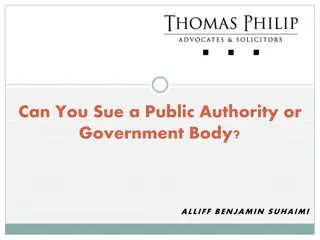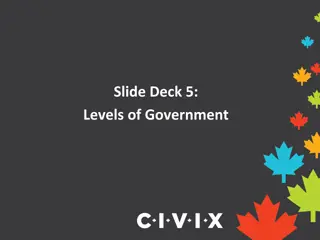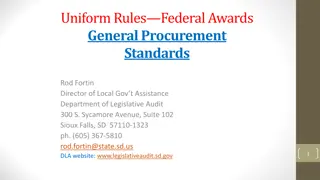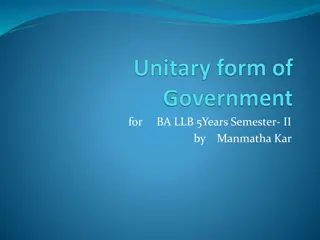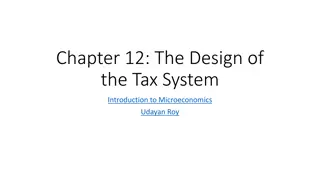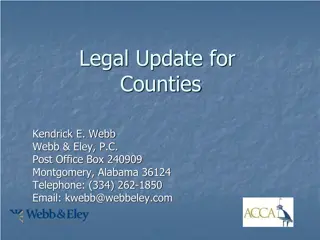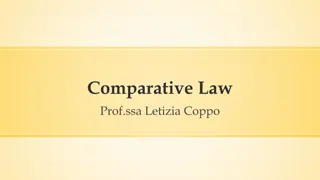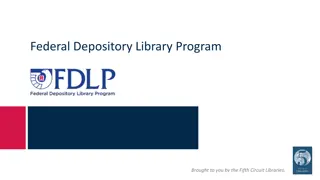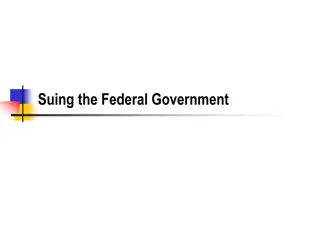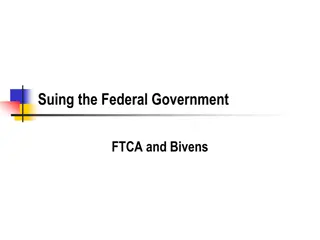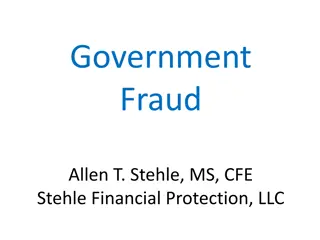Suing the Federal Government
In this content, explore the history, formation of the Court of Claims, jurisdiction, and the Federal Tort Claims Act (FTCA). Delve into Dalehite v. U.S. case and the negligence claims against the government, shedding light on key legal aspects.
Download Presentation

Please find below an Image/Link to download the presentation.
The content on the website is provided AS IS for your information and personal use only. It may not be sold, licensed, or shared on other websites without obtaining consent from the author.If you encounter any issues during the download, it is possible that the publisher has removed the file from their server.
You are allowed to download the files provided on this website for personal or commercial use, subject to the condition that they are used lawfully. All files are the property of their respective owners.
The content on the website is provided AS IS for your information and personal use only. It may not be sold, licensed, or shared on other websites without obtaining consent from the author.
E N D
Presentation Transcript
Suing the Federal Government FTCA and Bivens
History US Constitution "No Money shall be drawn from the Treasury, but in Consequence of Appropriations made by Law." U.S. Const. art. I, 9. Traditional Sovereign Immunity Takings Exception nor shall private property be taken for public use, without just compensation. 5thAmd. All compensation had to be by private bills What problems do private bills pose? 2
Formation of the Court of Claims 1855 Administrative tribunal to review claims and make recommendations to Congress Later Congress made the decisions binding Not an Art III court Like bankruptcy courts Appeal to the Federal circuit and the United States Supreme Court 3
Court of Claims Jurisdiction Contracts, tax refunds, takings Not torts Recently some court of claims judges are transforming takings law into tort law. After the failure of the FTCA case involved MRGO, a Court of Claims judge used the same evidence to find a taking. This is still in progress 4
Federal Tort Claims Act Went into effect in 1945 All torts were private bills before then Tied up Congress and encouraged corruption Provides an administrative compensation for certain tort injuries. Looks to the law of the state where the tort occurred for the standards for the tort We will discuss FTCA procedure later. 5
Dalehite v. U.S., 346 U.S. 15 (1953) Texas City Disaster http://www.local1259iaff.org/disaster.html Why is the TVA producing ammonium nitrate fertilizer? What are other uses of ammonium nitrate? Why are we shipping fertilizer to Europe post World War II? 6
The General Claim The negligence charged was that the United States, without definitive investigation of FGAN properties, shipped or permitted shipment to a congested area without warning of the possibility of explosion under certain conditions. LNG terminals? The District Court accepted this theory. 7
Specific Findings by the Trial Court the Government had been careless in drafting and adopting the fertilizer export plan as a whole, specific negligence in various phases of the manufacturing process, and those which emphasized official dereliction of duty in failing to police the shipboard loading. Classic private tort negligence claims. 8
The Statutory Defense (a) Any claim based upon an act or omission of an employee of the Government, exercising due care, in the execution of a statute or regulation, whether or not such statute or regulation be valid, or based upon the exercise or performance or the failure to exercise or perform a discretionary function or duty on the part of a federal agency or an employee of the Government, whether or not the discretion involved be abused. 9
What did the Court say about Discretion? So we know that the draftsmen did not intend it to relieve the Government from liability for such common-law torts as an automobile collision caused by the negligence of an employee of the administering agency. We know it was intended to cover more than the administration of a statute or regulation because it appears disjunctively in the second phrase of the section. The "discretion" protected by the section is not that of the judge -- a power to decide within the limits of positive rules of law subject to judicial review. It is the discretion of the executive or the administrator to act according to one's judgment of the best course, a concept of substantial historical ancestry in American law.
What is the Intent of this Provision? What is a discretionary function? Why do we limit claims based on government decisionmaking? What are the consequences for allowing litigants to challenge government polices? How does this mirror juridical review of rules and adjudications? What is the remedy for bad decisions? What about compensation? 11
The United States Supreme Court Ruling The District Court's holding that the Coast Guard and other agencies were negligent in failing to prevent the fire by regulating storage or loading of the fertilizer in some different fashion is like his specific citations of negligence discussed above. They are classically within the exception. "The power to adopt regulations or bylaws . . . for the preservation of the public health, or to pass ordinances prescribing and regulating the duties of policemen and firemen . . . are generally regarded as discretionary, because, in their nature, they are legislative." The courts have traditionally refused to question the judgments on which they are based.
The United States Supreme Court Ruling What was the dissent concerned about? What are the implications of limiting the liability of the federal government? Why was the majority reticent to make the leap from no liability to full tort liability? 13
Allen v. United States, 816 F.2d 1417 (10th Cir. 1987) In 1950 the AEC chose an area in Nevada as a testing site. The President approved this choice. Thereafter, between 1951 and 1962, eight series of open-air tests were conducted, with the President approving each series of tests. Over one hundred atomic bombs were detonated. Each test explosion was executed according to detailed plans which the AEC officially reviewed and adopted. Separate plans for protecting the public, and for providing the public with appropriate information, were also adopted by the AEC. 14
What are the Plaintiffs Claims? At trial, as a basis for governmental liability, plaintiffs singled out the alleged failure of the government, especially of the Radsafe Officers and the Test Information Officers, to fully monitor offsite fallout exposure and to fully provide needed public information on radioactive fallout. What would have been the effect if the government has told everyone that they were going to be exposed to dangerous, persistent contamination with radioactive material? 15
What Facts did the Trial Court Find? ...the trial court found that the people who designed the downwind safety program deviated from optimum practices based on the best available scientific knowledge. ...the trial court found the following deviations in the plans which would clearly support liability for injury under standard tort analysis as applied by the trial court: the decision to monitor randomly rather than on a "comprehensive, person- specific basis, decisions not to use thyroid or whole body counters decisions regarding the limited extent of urine, fecal, and blood sampling the decision not to test milk samples "in order to avoid arousing public concern, the decisions to forego internal fallout assessment from inhalation of fallout particles decisions regarding the extent of follow-up monitoring in downwind communities et.c. for several more findings. 16
What was the District Courts Legal Holding? Again, on a fully supported record, the trial court found that these departures from accepted safety standards were the proximate cause of suffering and death from cancer in many of the plaintiffs. Under the then-available legal precedents, the trial court reasonably concluded that the FTCA showed Congress's intent that the Government, which benefited from the testing, should bear these particular costs. How was this different from Dalehite? 17
What was the Governments Defense? Did the government deny that they caused any injuries? Was this an accident? What did the government intend to do? What was the public policy trade-off? National security? Cost-benefit? How does this presage Mathews? Is intentionally putting the public at risk, or even injuring the public, a protected discretionary function? 18
The Supreme Court Ruling on Liability In the instant case, no evidence was presented of any act or omission of the AEC or its employees that clearly contravened a specific statutory or regulatory duty, or that exceeded statutory or regulatory authority. There was no evidence, for example, that the Test Information Officer failed to release information he was required to give out, or that the Radsafe Officer failed to take a specific radiation measurement that had been decided upon. Plaintiffs' entire case rests on the fact that the government could have made better plans. This is probably correct, but it is insufficient for FTCA liability. What would be the result if the agency had violated a statute or regulation? 19
Is there a Duty to Protect the Public? It is irrelevant to the discretion issue whether the AEC or its employees were negligent in failing to adequately" protect the public. When the conduct at issue involves the exercise of discretion by a government agency or employee, 2680(a) preserves governmental immunity "whether or not the discretion involved be abused." For better or worse, plaintiffs here "obtain their 'right to sue from Congress [and] necessarily must take it subject to such restrictions as have been imposed.'"
The Supreme Court Ruling on Policy Our decision here adheres to the principle enunciated by the Supreme Court of broad sovereign immunity. An inevitable consequence of that sovereign immunity is that the United States may escape legal responsibility for injuries that would be compensible if caused by a private party. There remain administrative and legislative remedies; we note the express authorization under 42 U.S.C. 2012(i) for the government to make funds available for damages suffered by the public from nuclear incidents. Nonetheless, judicial reluctance to recognize the sometimes harsh principle of sovereign immunity explains much of the tangle of the prior FTCA cases. What is the path for compensation when you are injured by government policy? 21
Polio Vaccine Salk vaccine Dead virus - supposedly Sabin vaccine Live, attenuated vaccine Gives a mild infection Can spread to others - which is good What if someone is immunosuppressed? 23
Cutter Incident During the first wave of vaccinations when the vaccine became available in 1955 Some vaccine was not killed and children became infected Remember, there is still polio in the community at this time First vaccine litigation Real injuries, but a real benefit 24
Post Cutter Incident Undermined confidence in vaccines 1965 - 402 A made vaccine cases easier to prove There was some natural spread from Sabin virus 25
Swine Flu 1974-75 flu season New strain of flu that was thought to resemble the 1918-1919 Spanish Influenza Feds did a massive vaccine campaign Companies demanded immunity for lawsuits Congress let plaintiffs substitute the feds as plaintiff, and allowed strict liability theories 26
Swine Flu - Legal Consequences Huge incentive to find injuries Diagnosis of Guillain-Barre syndrome was ambiguous No lab test vague finding in all but the extreme cases Docs were encouraged to make the diagnosis Maybe the first big injury case where plaintiff's attorneys shaped the epidemiology and perception of the disease Berkovitz happened in this climate - 1979 27
Berkovitz by Berkovitz v. U.S., 486 U.S. 531 (1988) What was the product in Berkovitz? What did the FDA regulations require? What did the plaintiffs claim the FDA failed to do? What was the FDA s defense? 28
Varig Airlines (in Berkovitz) What was the injury in Varig Airlines? What did the enabling act require the agency to do? What did the regs require? How are the regs in Berkovitz different from those in Varig Airlines? 29
Agency Liability Why was the FDA liable in Berkovitz? How could the FDA have worded the regulations to avoid this sort of liability? Why might that have raised a red flag during notice and comment? 30
Epilog National Vaccine Injury Compensation Act Autism Scam Based on fraudulent research Tries to get around the act by blaming the preservative Attacks on adult vaccines like anthrax Undermined the mandatory immunization system 31
Causes of Action under the FTCA - Sec 2672 The head of each Federal agency ... may consider, ascertain, adjust, determine, compromise, and settle any claim for money damages against the United States for injury or loss of property or personal injury or death caused by the negligent or wrongful act or omission of any employee of the agency while acting within the scope of his office or employment, under circumstances where the United States, if a private person, would be liable to the claimant in accordance with the law of the place where the act or omission occurred 33
Limitations on Liability - Sec 2674 The United States shall be liable, respecting the provisions of this title relating to tort claims, in the same manner and to the same extent as a private individual under like circumstances, but shall not be liable for interest prior to judgment or for punitive damages. If, however, in any case wherein death was caused, the law of the place where the act or omission complained of occurred provides, or has been construed to provide, for damages only punitive in nature, the United States shall be liable for actual or compensatory damages, measured by the pecuniary injuries resulting from such death to the persons respectively, for whose benefit the action was brought, in lieu thereof. [When the FTCA was passed, dead people were not worth much in many states.] 34
Exceptions to the FTCA - 28 USC Sec 2680 http://biotech.law.lsu.edu/cases/immunity/ftca_exceptions.htm (h) originally did not include this language: Provided, That, with regard to acts or omissions of investigative or law enforcement officers of the United States Government, the provisions of this chapter and section 1346(b) of this title shall apply to any claim arising, on or after the date of the enactment of this proviso, out of assault, battery, false imprisonment, false arrest, abuse of process, or malicious prosecution. For the purpose of this subsection, "investigative or law enforcement officer" means any officer of the United States who is empowered by law to execute searches, to seize evidence, or to make arrests for violations of Federal law. 35
Bivens v. Six Unknown Named Agents, 403 U.S. 388 (1971) Bivens recognized that there is a direct action against federal employees for violations of constitutional rights not covered by the FTCA. Bivens is a personal action, not an official capacity action. No vicarious liability. You must show supervisors know and support the actions that cause the injury. 36
2680(h) - intentional torts by police officers - revised after Bivens Has become a substitute for a Bivens action for covered officers. When would a Bivens action still be possible for intentional torts? Remember there are other employees whose intentional torts are not covered by the FTCA. A recent case allows a Bivens action against federal medical personnel in a detention center for conscious indifference to a prisoner s medical needs. 37
Administrative Procedural Requirements - Sec 2675 An action shall not be instituted upon a claim against the United States for money damages for injury or loss of property or personal injury or death caused by the negligent or wrongful act or omission of any employee of the Government while acting within the scope of his office or employment, unless the claimant shall have first presented the claim to the appropriate Federal agency and his claim shall have been finally denied by the agency in writing and sent by certified or registered mail. 38
What if the Agency Does Not Act on the Claim? The failure of an agency to make final disposition of a claim within six months after it is filed shall, at the option of the claimant any time thereafter, be deemed a final denial of the claim for purposes of this section. 39
Filing a Claim is Jurisdictional This is an administrative compensation scheme, so it is subject to exhaustion of remedies You file a claim with the agency with 2 years of the accidence You can only go to court after the agency rules on the claim or after six months "The failure of an agency to make final disposition of a claim within six months after it is filed shall, at the option of the claimant any time thereafter, be deemed a final denial of the claim for purposes of this section." If you do not comply with this requirement, your case will be dismissed, and if the 2 years has elapsed, you will be prescribed. 40
Suing the Military Exception to FTCA (j) Any claim arising out of the combatant activities of the military or naval forces, or the Coast Guard, during time of war. Civilians can sue subject to this exception Activity duty military Feres v. U.S., 340 U.S. 135 (1950) Cannot sue military provides its own comp system Would undermine military discipline 41
Tort Claims in Louisiana Gregor v. Argenot Great Central Insurance Co., 851 So.2d 959 (La. 2003)
Sovereign Immunity in Louisiana The 1974 Louisiana Constitution (Edwin Edwards Constitution) abolished sovereign immunity for the state and its political subdivisions. Assuming there is no LATCA, how is the situation different from the feds? What is the rule when you are construing a statute that establishes immunity, as opposed to a statute in derogation of immunity?
La. R.S. 9:2798.1 LA Tort Claims Act Louisiana Revised Statute 9:2798.1(B) (DFE): Liability shall not be imposed on public entities or their officers or employees based upon the exercise or performance or the failure to exercise or perform their policymaking or discretionary acts when such acts are within the course and scope of their lawful powers and duties. Section D of La. R.S. 9:2798.1 explains that its purpose "is not to re-establish any immunity based on the status of sovereignty but rather to clarify the substantive content and parameters of application of such legislatively created codal articles and laws and also to assist in the implementation of Article II of the Constitution of Louisiana."
Exceptions to the DFE in the LATCA C. The provisions of Subsection B of this Section are not applicable: (1) To acts or omissions which are not reasonably related to the legitimate governmental objective for which the policymaking or discretionary power exists; or (2) To acts or omissions which constitute criminal, fraudulent, malicious, intentional, willful, outrageous, reckless, or flagrant misconduct. Remember that the FTCA DFE includes abuse of discretion is this different in LA?
What is a Discretionary Function? Under the FTCA, the courts use a very broad notion of discretionary function because it is a statute in derogation of immunity. Under state TCAs, including LA, the courts use a much more narrow notion and there are endless fights about what is covered. Clearing ice from roads is not covered. Greene v. Succession of Alvarado, 2015-1960 (La. App. 1 Cir. 12/27/16), 210 So. 3d 321
Procedure for Filing an LA Tort Claim In general, you just go to court, you do not have to file an administrative demand. Medical malpractice cases against governmental entities have to comply with the general LA legislation on medical malpractice, which does require notice and an administrative process for screening the cases.
Can You Collect a Judgment? (C) Limitations; Procedure; Judgments. Notwithstanding Paragraph (A) or (B) or any other provision of this constitution, the legislature by law may limit or provide for the extent of liability of the state, a state agency, or a political subdivision in all cases, including the circumstances giving rise to liability and the kinds and amounts of recoverable damages. It shall provide a procedure for suits against the state, a state agency, or a political subdivision and provide for the effect of a judgment, but no public property or public funds shall be subject to seizure. The legislature may provide that such limitations, procedures, and effects of judgments shall be applicable to existing as well as future claims. No judgment against the state, a state agency, or a political subdivision shall be exigible, payable, or paid except from funds appropriated therefor by the legislature or by the political subdivision against which the judgment is rendered. (emphasis added)
Raw Oysters What do oysters eat? Hepatitis A - traditional Liver disease some die vibrio vulnificus - the new threat acute liver disease and failure various other nasty vibrios This is why God made deep fat fryers 49
Tort Standards for Oysters The foreign/natural distinction Cherry pits, chicken bones The consumer expectations test Is it something that a reasonable consumer would expect to be in the food? This is the prevailing view. Do consumers expect vibrio vulnificus or hepatitis A? What about dying from fugu - puffer fish - sushi? Why do the oyster producers and restaurants want a statutory warning?
